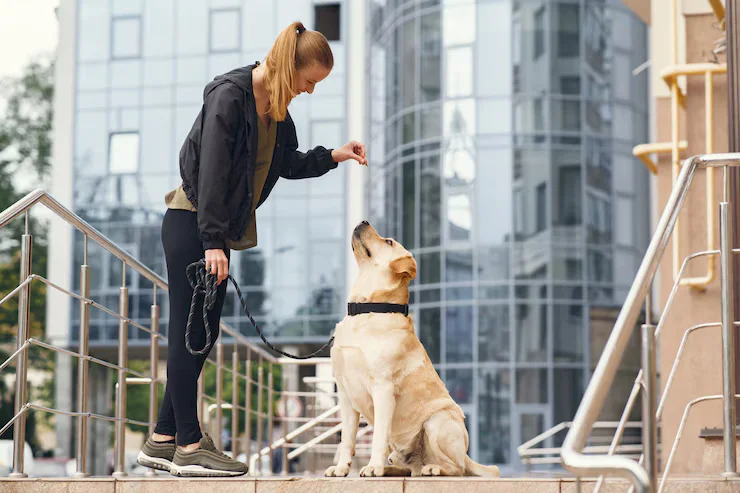Dog growling is a natural form of communication, not disobedience. Punishing it suppresses warning signals, increasing the risk of unpredictable aggression. Understanding why dogs growl helps prevent fear, anxiety, and broken trust.
Understanding Why Dogs GrowlThe Role of Dog Growling in Canine Communication
Dogs use a variety of sounds and body language to express their needs and emotions. A wagging tail and excited barking might signal happiness, while whining or pawing at their food bowl can indicate hunger. Subtle cues like ear position, facial expressions, and body posture also play a role in how they communicate with humans and other animals.
Dog growling is another important part of canine communication. The RSPCA highlights that growling serves as a warning signal, letting us know when a dog feels discomfort. Recognising this helps owners address the issue, reducing the risk of unwanted behaviour.
Misconceptions About Growling and Aggression
Many people assume growling is a sign of aggression, defiance, or dominance, but it’s simply a dog’s way of saying, “I’m not okay with this.” It’s not an act of rebellion but a clear warning that something is making them uncomfortable. Recognising this allows owners to address the underlying cause rather than suppressing the behaviour.
Dogs that learn their growls are ignored or punished may stop using this warning altogether and resort to more extreme reactions, like snapping or biting. This not only puts people and other animals at greater risk but also increases the dog’s own stress and anxiety.
How Growling Prevents Escalation to Biting
When a dog growls, it’s sending a clear warning that something is wrong. Recognising and respecting a dog’s growl helps prevent escalation to biting, allowing owners to intervene before the situation worsens. This moment provides the opportunity to:
Identify what’s causing the discomfort
Recognise whether the dog is afraid, in pain, or feeling threatened
Take action to ease the situation and prevent escalation
For owners who want to better understand their dog’s signals and respond properly,professional dog training can be helpful. Working with a trainer helps improve communication, reducing stress for both the dog and the owner.
Types of Growls and What They MeanFear-Based Growling
Fear growling happens when a dog feels cornered, overwhelmed, or unsure about a situation. It’s their way of asking for space and letting others know they’re uncomfortable. A dog that growls out of fear isn’t trying to be aggressive—they’re simply expressing distress in the only way they know how.
Whether it’s triggered by a loud noise, an unfamiliar person, or a past trauma, address the issue with patience is key. Positive reinforcement, such as rewarding calm behaviour and gradually introducing the dog to its fears, can help reduce fearful reactions over time.
Play Growling vs. Warning Growling
Play growling is a natural part of how dogs interact, especially during games like tug-of-war or friendly wrestling with other dogs. It’s often accompanied by loose, wiggly body movements, a wagging tail, and an overall relaxed demeanour. This type of growling is playful and light-hearted, helping dogs communicate excitement during fun activities.
On the other hand, a warning growl sounds deeper and more intense, often paired with stiff body language, raised hackles, or avoidance behaviours. Recognising the difference between playful and warning growls helps owners respond appropriately.
Pain-Related Growling
When a dog is in pain, growling can be their way of saying, “That hurts, please stop.” This might happen if they have an injury, joint issues, or an underlying health condition. Even the gentlest touch can trigger a growl if it causes pain, and in these moments, the dog isn’t being aggressive—they’re simply trying to protect themselves from further discomfort.
If a dog suddenly starts growling without an obvious reason, it’s important to consider the possibility of pain or illness. Changes in behaviour, such as reluctance to move, sensitivity to touch, or withdrawing from interaction, can be signs to pay the vet a visit.
Territorial and Possessive Growling
Territorial growling occurs when a dog feels the need to protect its space. This could be a stranger approaching the front door, another dog entering their yard, or even a new visitor in the home. Dogs are naturally protective of their environment, and growling is their way of saying, “This is my space, and I’m unsure about you.”
Possessive growling, on the other hand, happens when a dog guards something valuable to them, such as food, toys, or even a favourite resting spot. Owners should work on building trust through positive reinforcement, teaching their dog that they don’t need to defend their resources.
Training techniques that can help reduce territorial and possessive tendencies include:
Trade-ups (exchanging a valued item for something better)
Desensitisation (gradual exposure to reduce guarding behaviour)
Reinforcing calm behaviour (rewarding a relaxed response)
All of these behaviours stem from their natural survival instincts but can become problematic if left unchecked.
Effective Strategies for Managing and Modifying Reactive BehaviourRecognising Early Warning Signs
By addressing a dog’s discomfort early, owners can step in before the situation escalates to a growl or bite. Dogs rarely growl without warning—before reaching that point, they often display subtle signs of discomfort, such as:
Lip licking or excessive yawning.
Ears pinned back or body stiffening.
Avoiding eye contact or moving away.
Raised hackles or a tucked tail.
Dog owners can benefit from one-on-one training sessions to gain deeper insights into their dog’s behavioral cues and how to respond appropriately.
Positive Reinforcement Techniques
Positive reinforcement is widely recognized as an effective method for training and behavior modification in dogs. The RSPCA promotes reward-based training methods to foster a trusting relationship. Training should focus on reinforcing desirable behaviors:
Reward calm behavior: Treats, praise, or toys can reinforce positive reactions to stressful situations.
Redirect attention: Using commands like “look at me” or offering a favorite toy can help shift focus from a trigger.
Create positive associations: Gradually exposing a dog to stressors with rewards can reduce fear-based responses.
This method strengthens trust and encourages appropriate behaviors while reducing reactivity. If you’re looking for structured training programs, consider enrolling in puppy training classes.
Desensitisation and Counter-Conditioning
These techniques involve gradually exposing the dog to the stimulus that triggers its growling while pairing the experience with positive reinforcement, such as treats, praise, or play. The goal is to change the dog’s emotional response from fear or discomfort to a more relaxed and positive state.
Dog training professionals often use these methods to address fear-based behaviours, focusing on patience and consistency to achieve lasting results. Rather than forcing a dog to tolerate a stressful situation, trainers help dogs build confidence at their own pace.
When to Seek Professional Help
If a dog’s growling continues despite efforts to manage it positively, or if it starts to escalate into more concerning behaviours like lunging or snapping, seeking professional guidance is essential. A qualified dog behaviourist or trainer can assess the underlying causes and provide tailored strategies to help your dog.
Puppy to Dog School offers reactive dog training designed to help owners manage reactivity in a safe and controlled environment. In cases where anxiety or medical issues contribute to reactive behaviour, a veterinarian or veterinary behaviourist can provide additional guidance.
Key Takeaways
Dog growling is a normal and necessary form of communication that should not be punished.
Suppressing growling increases the risk of unpredictable aggression and damages trust between dogs and owners.
Identifying the reason behind growling and using positive reinforcement techniques create a safer and more effective approach to behaviour management.
Understanding and respecting a dog’s communication fosters a stronger, more positive human-dog relationship.







